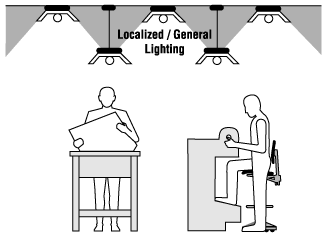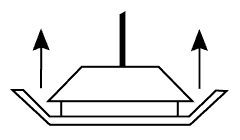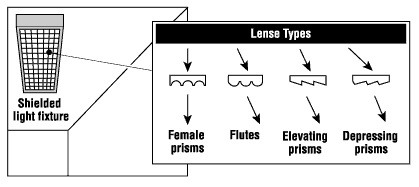Lighting Ergonomics – General Fact Sheets
WHY IS LIGHTING IMPORTANT?
How is anthrax contracted?
Whether in industrial or office settings, proper lighting makes all work tasks easier. People receive about 85 percent of their information through their sense of sight. Appropriate lighting, without glare or shadows, can reduce eye fatigue and headaches; it can prevent workplace incidents by increasing the visibility of moving machinery and other safety hazards. Good quality lighting also reduces the chance of incidents and injuries from “momentary blindness” (momentary low field vision due to eyes adjusting from brighter to darker, or vice-versa, surroundings).
The ability to “see” at work depends not only on lighting but also on:
- The time to focus on an object. Fast moving objects are hard to see.
- The size of an object. Very small objects are hard to see.
- Brightness. Too much or too little reflected light makes objects hard to see.
- Contrast between an object and its immediate background. Too little contrast makes it hard to distinguish an object from the background.
WHAT ARE DIFFERENT SOURCES OF LIGHT?
Daylight: How much daylight reaches inside a building depends on the architecture of the building (does the building have windows? how big? how are they oriented?), the amount and direction of sunlight, cloud cover, local terrain, and the season. The cleanliness of the windows is important as well. The amount of daylight entering the workplace can be controlled with tinted glass, window blinds, curtains, and awnings. Daylight is desirable in the workplace providing it does not cause glare or make the work area too bright.
Remember, not enough light can also be a problem so even in workplaces where daylight is available, it is essential to have a good electric lighting system.
Electric Lighting: The amount of light, the colour of the light itself and the colour that objects appear vary with the type of electric lighting. The lighting must match the workplace and the task. The following are common types of bulbs.
| Light Bulbs* | |||
|---|---|---|---|
| Type | Common Application | Efficiency | Colour Rendering** |
| Incandescent | homes | poor | good |
| Fluorescent, including compact fluorescent lights | offices | good | fair to good |
| Mercury | factories, offices | fair | fair to moderate |
| Low pressure sodium | roadway | good | poor |
| High pressure sodium | factories, commercial | good | fair to good |
| Metal Halide | factories, commercial | good | good |
| LED (light-emitting diodes) | homes, offices | good | fair to good |
* Bulbs are often referred to as lamps in many technical publications.
** Colour rendering is the effect of light on the colour of objects.
WHAT ARE BASIC TYPES OF ARTIFICIAL LIGHTING?
There are three basic types of lighting:
- General.
- Localized-general
- Local (or task).
General lighting provides fairly uniform lighting. An example would be ceiling fixtures that light up large areas.

Localized-general lighting uses overhead fixtures in addition to ceiling fixtures to increase lighting levels for particular tasks.

Local (or task) lighting increases light levels over the work and immediate surroundings. Local lighting often allows the user to adjust and control lighting and provides flexibility for each user.

WHAT ARE DIFFERENT TYPES OF LIGHT FIXTURES?
The complete lighting unit (also called the light fixture) controls and distributes the light. (Light fixtures are often referred to as “luminaires” in technical publications.)
Various types of light fixtures are designed to distribute light in different ways. These fixtures are known as:
- Direct.
- Direct-indirect.
- Indirect.
- Shielded (various types).
No single type of light fixture is appropriate in every situation. The amount and quality of lighting required for a particular workstation or task will determine which light fixture is most suitable.
Direct light fixtures project 90 to 100 percent of their light downward toward the work area. Direct lighting tends to create shadows.

Direct-indirect light fixtures distribute light equally upward and downward. They reflect light off the ceiling and other room surfaces. Little light is emitted horizontally meaning direct glare is often reduced. They are usually used in “clean” manufacturing areas.

Indirect light fixtures distribute 90 to 100 percent of the light upward. The ceiling and upper walls must be clean and highly reflective to allow the light to reach the work area. They provide the most even illumination of all the types of fixtures and the least direct glare. Indirect light fixtures are usually used in offices.

Shielded light fixtures use diffusers, lenses and louvers to cover bulbs from direct view; therefore, helping to prevent glare and distribute light.
Diffusers are translucent or semi-transparent (see-through) covers made usually of glass or plastic. They are used on the bottom or sides of light fixtures to control brightness.
Lenses are clear or transparent glass, or plastic covers. The lens design incorporates prisms and flutes to distribute light in specific ways.

Louvers are baffles that shield the bulb from view and reflect light. The baffles can be contoured to control light and decrease brightness. Parabolic louvers are specially shaped grids that concentrate and distribute light.

CAN ELECTRIC LIGHTING AFFECT WHAT WE “SEE” AS THE COLOURS OF AN OBJECT?
Yes. The “colour” of an object actually depends upon the colour composition of the light itself as well as the colours of the light that the object reflects and absorbs.
Natural sunlight is made up of all the colours of the rainbow (spectrum): red, orange, yellow, green, blue, indigo and violet. Most electric lights do not “make” of all these colours even though the lights appear to be emitting “white” or “normal” light. In fact, different lights give different colour rendering characteristics. As a result, the true colour of an object can only be determined when viewed under sunlight or under lighting, such as full spectrum lighting, that has the same spectral composition as sunlight.
For most work situations, colour rendering is not an issue. However, full spectrum lighting may be needed when colour judgement is important; for example, in a fabric manufacturing or sewing environment.
Source: © Copyright 1997-2021 CCOHS